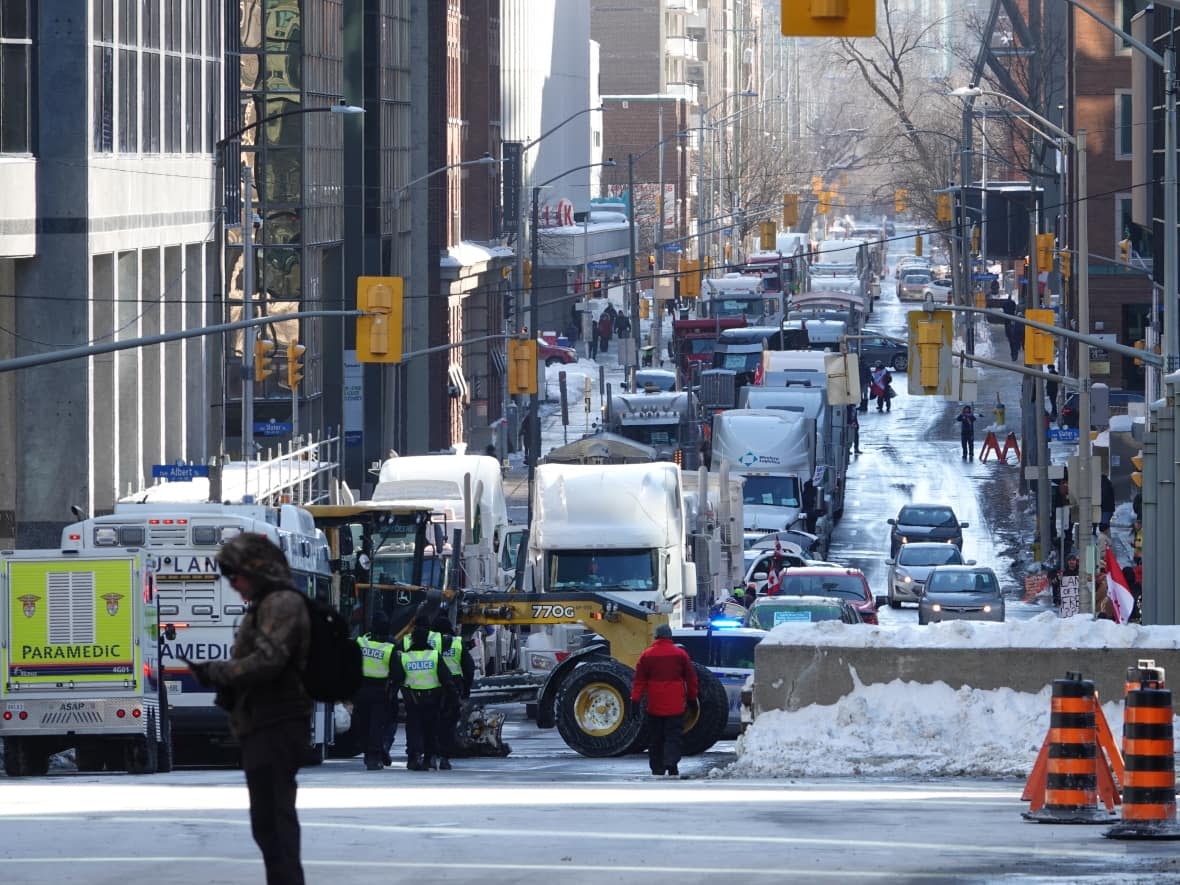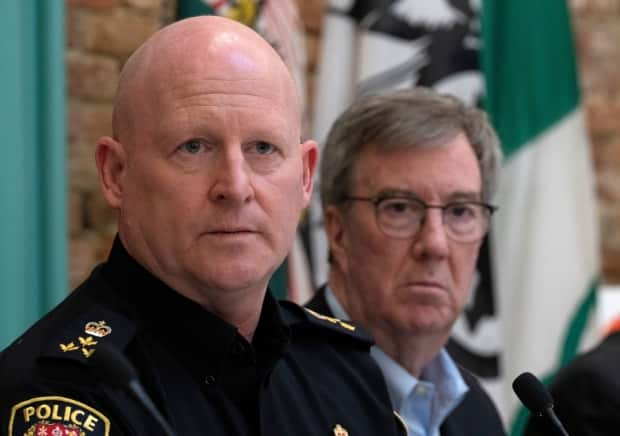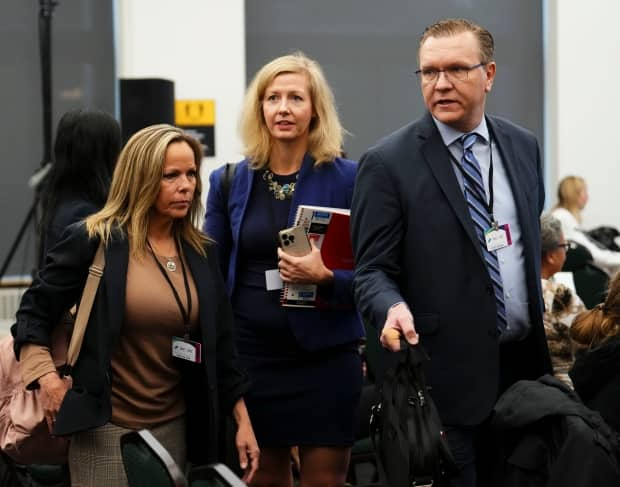How a plan to end the convoy protest came together — and why it failed

Ottawa city manager Steve Kanellakos revealed new details Monday about a last-ditch agreement between police, protesters and politicians to move trucks out of residential areas and onto Wellington Street during last winter's convoy protest in the capital — a deal that would ultimately fall apart just days before the federal government gave police special powers to end the occupation.
Kanellakos was testifying on the third day of the Public Order Emergency Commission, which was triggered when the Emergencies Act was invoked on Feb. 14.
Six days earlier, on the morning of Tuesday, Feb. 8, Kanellakos was making his way to his office in the heritage wing of Ottawa city hall when his phone rang. It was Steve Bell, deputy chief of the Ottawa Police Service (OPS).
Despite earlier assurances from police that the protesters would likely leave the city after the first weekend of demonstrations, many had remained through a second tense weekend and were showing no signs of leaving.
Two days earlier, Ottawa Mayor Jim Watson had declared a state of emergency, and the previous week then police chief Peter Sloly had declared he was becoming increasingly concerned there was "no policing solution" to the impasse.
Plan to move trucks
Kanellakos was by that time convinced Ottawa police alone couldn't end the occupation, but negotiations with upper levels of government were proving fruitless and frustrating. Towing companies with the kind of equipment needed to haul away tractor-trailers refused to get involved, either out of fear for their employees' safety or sympathy with the protesters.
Bell, who would soon take over as interim chief after Sloly's resignation, was looking for a different kind of solution, but he needed Kanellakos's help.

The plan was to hammer out an agreement with protest leaders to move the vehicles clogging residential areas of Ottawa's downtown onto Wellington Street, giving downtown residents some much-needed respite from the noise and disruption, and giving police a more manageable geographic area to work within.
Bell explained that talks between police and protesters had broken down, but protest leaders had asked for a meeting with someone at city hall.
"I was reluctant when he first told me. We never had any intention ... of meeting with the protest leaders. That wasn't on our radar or anything we were planning to do," Kanellakos testified.
"I wasn't convinced that I should meet with them because I felt that that was opening up another door in terms of a signal that we're prepared to start negotiating."
Mayor 'thought it was a bad idea'
Kanellakos consulted with Watson, who he said was also reluctant because he suspected the protesters of trying to use talks with the city as a ploy to draw the federal government to the negotiating table.
"He didn't tell me not to meet them, and he didn't tell me to meet them," Kanellakos recalled. "He just thought it was a bad idea."
Despite his own reservations, Kanellakos offered to handle the meeting without getting the mayor involved.
"No one was meeting with them, of an official capacity, at the political level," he said.

A team of police liaison officers was dispatched to a nearby hotel and returned around noon with protest leader Tom Marazzo, as well as Keith Wilson and Eva Chipiuk, lawyers who are representing the convoy organizers at the inquiry.
Marazzo asked to speak alone with Kanellakos, and the two men entered a boardroom and shut the door.
"Tom and I began having a conversation about why they're here, his background, what happened to him, his story, just getting to know each other, basically," Kanellakos testified.
Marazzo pushed for a meeting with the mayor, but Kanellakos told the convoy leader he'd need to demonstrate some "good faith" before that happened.
Deal struck
It was agreed that gesture would involve moving trucks out of residential neighbourhoods, and by the end of the 90-minute meeting, both sides had agreed to work out the basic terms of a deal.
By that Saturday, an agreement letter had been drafted and signed by Watson and protest leader Tamara Lich. It was released to the public on Sunday, Feb. 13.
That night, protest leaders, police and other city officials reconvened in the mayor's boardroom to finalize the logistics. Acting Supt. Rob Drummond, assigned by Sloly to execute the plan, produced a map showing where the trucks would be moved.
"He was basically laying out how that operation would unfold the next morning," Kanellakos said. "When we left the meeting ... we had a map of where the trucks would be moved."
Already, there were concerns. The protesters wanted to claim more real estate along the Sir John A. Macdonald Parkway, but police and city officials were adamant the bulk of the trucks be moved to Wellington Street, with overflow being directed to a designated area west of the city.
Meanwhile, Sloly was worried about whether OPS had the resources to successfully complete the operation
"He was concerned about his ability to do that," Kanellakos said, but Bell and acting deputy chief Trish Ferguson were behind the plan.
At the same time, protest leaders agreed to fan out that night and go "truck by truck, talking with everybody to get them in line."
Problems out of the gate
Things didn't go according to plan, however. First, owing to what Kanellakos characterized as "communications issues," some police officers refused to let more trucks enter Wellington Street. Eventually, about 40 vehicles were allowed onto the street.
The bigger problem was that many of the protesters in pickup trucks and other lighter vehicles refused to move from the residential streets where they were parked, and some even blocked the effort to concentrate the protest on Wellington Street, Kanellakos said.
"There wasn't an alignment of purpose by everybody that was on all those streets. They had different reasons for wanting to stay."

There was also pushback from Larry Brookson, acting director of the Parliamentary Protective Service, who registered his displeasure in a text message to Kanellakos.
"Quite honestly Steve, I'm at a loss at how this sort of agreement could have been worked out with a clear disregard to security, especially considering we just finished a bomb blast assessment which included a threat of explosives being transferred via large vehicles," Brookson wrote.
Kanellakos testified that Brookson should have been well aware of the plan, and pointed out that by that time "hundreds" of heavy vehicles had already been occupying Parliament Hill.
By the next day, none of it mattered anyway.
"The deal had fallen apart in terms of moving the trucks anyways up onto Wellington Street by Tuesday," Kanellakos said.
Nor did the meeting between the mayor and the protesters ever take place.
"They never fulfilled their end of the bargain, so he never met with them."
Watson is scheduled to appear before the commission on Tuesday.


